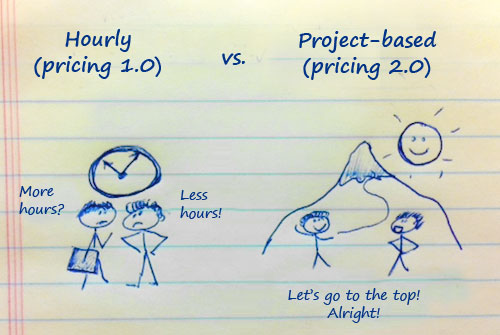Many designers are uncomfortable discussing money, especially with friends or family, making pricing one of the most challenging aspects of their work. Consequently, many designers base their fees on hourly rates, which is actually a terrible idea.
At first glance, it seems simple: calculate the time spent, multiply it by a specific rate, and generate an invoice. However, this method is fraught with anxiety for the designer. As soon as it’s time to calculate the fee, questions start popping up in your mind:
- Should I charge for every hour spent?
- Will the client accept that it took this much time to complete the project?
- Most importantly, will they pay me?

Like many designers, you’re probably a bit of a perfectionist, always worried that your client won’t appreciate how much work and time went into the project (even if you dare to bill them for all the hours). Therefore, calculating fees on an hourly basis is one of the worst ways to approach creative work.
On the other hand, imagine a client is willing to pay $5,000 for a project, and due to your expertise and experience, you can complete it in a few hours. In this scenario, how important is the time spent? If the work is done well and is complete, receiving it sooner is valuable to the client.
With this approach, a designer’s income aligns with their experience and expertise. However, when the fee is calculated hourly, the opposite happens; the more experienced and faster you are, the sooner the project is finished, and the less you get paid.

However, if you’re forced to work on an hourly basis, consider these points:
- Learn pricing strategies in your field and apply the most suitable approach for each client. Sometimes you may need to combine several methods. After all, pricing creative work isn’t like selling a product; many factors must be considered.
- If the client understands your work process and appreciates the level of detail you put into their project, and you’re confident they’ll pay, then hourly rates might work in this exceptional situation. Hourly rates can even be the best option if you’re very particular about the quality of your work and don’t mind how long it takes. But be very careful not to exceed the agreed-upon time, otherwise, no matter how good your work is, you’ll lose both time and money.
The key to pricing is to avoid surprising the client. Consider the time, energy, and overhead costs of each project and set a price accordingly.

Summary of Key Points:
- Hourly rates can be problematic for designers.
- Experience and quality should be rewarded, not penalized.
- Consider the client’s understanding of your work and your confidence in their payment.
- Be transparent about your pricing and avoid surprises.
Overall, the article argues that while hourly rates might seem simple, they are often not the best approach for designers, especially those who value quality and efficiency.




